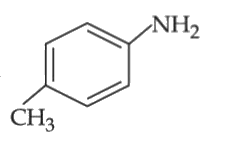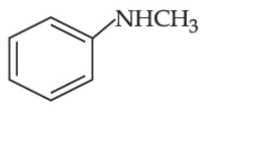Which one of the following gives the most stable Diazonium salt ?
CH3−CH3∣C∣H−NH2

CH3−CH2−CH2−NH2

To determine which diazonium salt is the most stable among the given options, we need to analyze the stability of diazonium salts formed from different types of amines.
1. Understand the Formation of Diazonium Salts:
- Diazonium salts are typically formed by the reaction of primary amines with nitrous acid (HNO2). The general reaction can be represented as:
RNH2+HNO2→R−N+2+Cl−
- Here, R represents the alkyl or aryl group attached to the amine.
2. Evaluate Stability of Alkyl Diazonium Salts:
- Alkyl diazonium salts (formed from primary aliphatic amines) are known to be highly unstable. For example, if we take methylamine (CH3NH2) and react it with nitrous acid, we get methyl diazonium chloride (CH3N2^+Cl^-), which is unstable and can decompose easily to form alcohols or other products.
3. Evaluate Stability of Aromatic Diazonium Salts:
- Aromatic amines, such as aniline (C6H5NH2), react with nitrous acid to form aryl diazonium salts (e.g., C6H5N2^+Cl^-). These salts are more stable compared to their alkyl counterparts, especially at low temperatures (273-278 K), where they can remain stable for a short time.
4. Consider Secondary Amines:
- Secondary amines do not form diazonium salts when reacted with nitrous acid. Instead, they form nitroso compounds, which means they cannot be considered for stability in this context.
5. Conclusion:
- Based on the analysis, the most stable diazonium salt is formed from an aromatic amine, specifically option 2, which is an aromatic amine (like aniline). Therefore, the answer is:
Option 2: Aromatic amine (e.g., Aniline)
- Diazonium salts are typically formed by the reaction of primary amines with nitrous acid (HNO2). The general reaction can be represented as:
RNH2+HNO2→R−N+2+Cl−
- Here, R represents the alkyl or aryl group attached to the amine.
- Alkyl diazonium salts (formed from primary aliphatic amines) are known to be highly unstable. For example, if we take methylamine (CH3NH2) and react it with nitrous acid, we get methyl diazonium chloride (CH3N2^+Cl^-), which is unstable and can decompose easily to form alcohols or other products.
- Aromatic amines, such as aniline (C6H5NH2), react with nitrous acid to form aryl diazonium salts (e.g., C6H5N2^+Cl^-). These salts are more stable compared to their alkyl counterparts, especially at low temperatures (273-278 K), where they can remain stable for a short time.
- Secondary amines do not form diazonium salts when reacted with nitrous acid. Instead, they form nitroso compounds, which means they cannot be considered for stability in this context.
- Based on the analysis, the most stable diazonium salt is formed from an aromatic amine, specifically option 2, which is an aromatic amine (like aniline). Therefore, the answer is:
Option 2: Aromatic amine (e.g., Aniline)
Topper's Solved these Questions
Similar Questions
Knowledge Check
Which of the following is the most stable diazonium salt?
AC6H5CH2N+2X−BCH3N+2X−CCH3CH2N+2X−DC6H5N+2X−Which of the following is the most stable diazonium salt?
AC6H5CH2N+2X−BCH3N+2X−CCH3CH2N+2X−DC6H5N+2X−Which one of the following should be most stable
AH+2BH+CHDH−